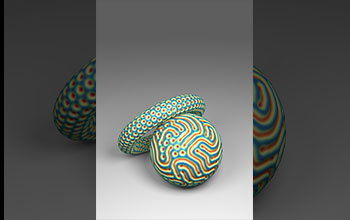Multimedia Gallery
Math equation predicts how surface patterns form on curved objects
Researchers at the Massachusetts Institute of Technology developed a mathematical equation that predicts how surface patterns form on curved objects. Pictured is a sphere with a combination of hexagons and labyrinthine patterns, and a more complex, torus-shaped object with hexagonal dimples.
More about this image
When a grape slowly dries and shrivels, its surface creases, ultimately taking on the wrinkled form of a raisin. Similar patterns can be found on the surfaces of other dried materials, as well as in human fingerprints. While these patterns have long been observed in nature, and more recently in experiments, scientists have not been able to come up with a way to predict how such patterns arise in curved systems, such as microlenses.
Now, from their calculations, the MIT team has determined that one main parameter -- curvature -- determines the type of pattern that forms. Curvature is one major determinant of whether a wrinkling surface becomes covered in hexagons or a more labyrinthine pattern. The more curved an object, the more regular its wrinkled surface. The thickness of an object's shell also plays a role. If the outer layer is very thin compared to its curvature, an object's surface will likely be convoluted, similar to a fingerprint. If the shell is a bit thicker, the surface will form a more hexagonal pattern.
The researchers say the theory may help to generally explain how fingerprints and wrinkles form. The research was funded in part by the U.S. National Science Foundation.
To learn more about this research, see the MIT news story Wrinkle predictions. (Date image taken: 2014; date originally posted to NSF Multimedia Gallery: Nov. 12, 2015)
Credit: Norbert Stoop
Images and other media in the National Science Foundation Multimedia Gallery are available for use in print and electronic material by NSF employees, members of the media, university staff, teachers and the general public. All media in the gallery are intended for personal, educational and nonprofit/non-commercial use only.
Images credited to the National Science Foundation, a federal agency, are in the public domain. The images were created by employees of the United States Government as part of their official duties or prepared by contractors as "works for hire" for NSF. You may freely use NSF-credited images and, at your discretion, credit NSF with a "Courtesy: National Science Foundation" notation.
Additional information about general usage can be found in Conditions.
Also Available:
Download the high-resolution JPG version of the image. (1.8 MB)
Use your mouse to right-click (Mac users may need to Ctrl-click) the link above and choose the option that will save the file or target to your computer.

 All images in this series
All images in this series